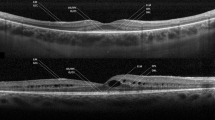Abstract
Purpose
To access the differential thickening of retinal layers in the epiretinal membrane (ERM) and to determine their correlation with visual acuity.
Methods
Prospective and comparative case series of 22 patients, each of whom has one unilateral ERM eye and one normal eye. The eyes with abnormal photoreceptor layer by OCT images were excluded. Spectral-domain optical coherence tomography (SD-OCT) images were generated with Spectralis OCT (Heidelberg Engineering, Heidelberg, Germany). The thicknesses were obtained by a volume scan program using manual segmentation of the total retina, inner retina, inner nuclear layer (INL), outer plexiform layer (OPL), and outer nuclear layer (ONL) in the fovea (1.0 mm diameter) and the parafovea (3.0 mm diameter). The thickness and the proportion of each retinal layer and their relationship with visual acuity were analyzed.
Results
All retinal layers of ERM eyes were thicker than the patients’ normal eyes (P < 0.05). In the fovea, the levels of thickness difference of inner retina (240.38%) and INL (266.26%) were significantly higher than total retina (126.7%). Visual acuity was not correlated with the retinal thickness in both ERM eyes and normal eyes (P > 0.05). However, significant correlations between visual acuity difference with retinal thickness difference were found in the total retina (rho = 0.450, P = 0.046) and the inner retina (rho = 0.602, P = 0.005) of the fovea, as well as in the inner retina (rho = 0.468, P = 0.037) and the INL (rho = 0.466, P = 0.039) of the parafovea. When we convert each retinal thickness into a proportion, in the foveal area, the percentages of thickness of the inner retina and the INL of ERM eye were significantly higher than that of the normal eye (P < 0.05), whereas that of the ONL was significantly lower (P < 0.05). In the parafoveal area, the percentage of thickness of the inner retina of the ERM eye was significantly higher than that of the normal eye (P < 0.05), whereas that of ONL was significantly lower (P < 0.05).
Conclusions
Idiopathic ERM affects the volume of all retinal layers. Inner retina had the most variability of thickness and is strongly associated with visual acuity changes in the case of intact photoreceptor layer.



Similar content being viewed by others
References
Gupta P, Sadun AA, Sebag J (2008) Multifocal retinal contraction in macular pucker analyzed by combined optical coherence tomography/scanning laser ophthalmoscopy. Retina 28:447–452
Massin P, Allouch C, Haouchine B, Metge F, Paques M, Tangui L, Erginay A, Gaudric A (2000) Optical coherence tomography of idiopathic macular epiretinal membranes before and after surgery. Am J Ophthalmol 130:732–739
Falkner-Radler CI, Glittenberg C, Hagen S, Benesch T, Binder S (2010) Spectral-domain optical coherence tomography for monitoring epiretinal membrane surgery. Ophthalmology 117:798–805
Alam S, Zawadzki RJ, Choi S, Gerth C, Park SS, Morse L, Werner JS (2006) Clinical application of rapid serial Fourier-domain optical coherence tomography for macular imaging. Ophthalmology 113:1425–1431
Srinivasan VJ, Wojtkowski M, Witkin AJ, Duker JS, Ko TH, Carvalho M, Schuman JS, Kowalczyk A, Fujimoto JG (2006) High-definition and 3-dimensional imaging of macular pathologies with high-speed ultrahigh-resolution optical coherence tomography. Ophthalmology 113:2054–2065
Mitamura Y, Hirano K, Baba T, Yamamoto S (2009) Correlation of visual recovery with presence of photoreceptor inner/outer segment junction in optical coherence images after epiretinal membrane surgery. Br J Ophthalmol 93:171–175
Suh MH, Seo JM, Park KH, Yu HG (2009) Associations between macular findings by optical coherence tomography and visual outcomes after epiretinal membrane removal. Am J Ophthalmol 147:473–480
Arichika S, Hangai M, Yoshimura N (2010) Correlation between thickening of the inner and outer retina and visual acuity in patients with epiretinal membrane. Retina 30:503–508
Watanabe A, Arimoto S, Nishi O (2009) Correlation between metamorphopsia and epiretinal membrane optical coherence tomography findings. Ophthalmology 116:1788–1793
Theodossiadis PG, Grigoropoulos VG, Kyriaki T, Emfietzoglou J, Vergados J, Nikolaidis P, Theodossiadis GP (2008) Evolution of idiopathic epiretinal membrane studied by optical coherence tomography. Eur J Ophthalmol 18:980–988
Del Priore LV (2006) Stiffness of retinal and choroidal tissue: a surface wrinkling analysis of epiretinal membranes and choroidal folds. Am J Ophthalmol 142:435–440
Wilkins JR, Puliafito CA, Hee MR, Duker JS, Reichel E, Coker JG, Schuman JS, Swanson EA, Fujimoto JG (1996) Characteristics of epiretinal membranes using optical coherence tomography. Ophthalmology 103:2142–2151
Mori K, Gehlbach PL, Sano A, Deguchi T, Yoneya S (2004) Comparison of epiretinal membranes of differing pathogenesis using optical coherence tomography. Retina 24:57–62
Michalewski J, Michalewska Z, Cisiecki S, Nawrocki J (2007) Morphologically functional correlations of macular pathology connected with epiretinal membrane formation in spectral optical coherence tomography (SOCT). Graefes Arch Clin Exp Ophthalmol 245:1623–1631
Kadonosono K, Itoh N, Nomura E, Ohno S (1999) Perifoveal microcirculation in eyes with epiretinal membranes. Br J Opthalmol 83:1329–1331
Tanikawa A, Horiguchi M, Kondo M, Suzuki S, Terasaki H, Miyake Y (1999) Abnormal focal macular electroretinograms in eyes with idiopathic epimacular membrane. Am J Ophthalmol 127:559–564
Gomes NL, Corcostegui I, Fine HF, Chang S (2009) Subfoveal pigment changes in patients with longstanding epiretinal membranes. Am J Ophthalmol 147:865–868
Legarreta JE, Gregori G, Knighton RW, Punjabi OS, Lalwani GA, Puliafito CA (2008) Three-dimensional spectral-domain optical coherence tomography images of the retina in the presence of epiretinal membranes. Am J Ophthalmol 145:1023–1030
Ishikawa H, Stein DM, Wollstein G, Beaton S, Fujimoto JG, Schuman JS (2005) Macular segmentation with optical coherence tomography. Invest Ophthalmol Vis Sci 46:2012–2017
Conflict of interest
The authors have no proprietary or financial interest in any of the products used in this study.
Author information
Authors and Affiliations
Corresponding author
Rights and permissions
About this article
Cite this article
Koo, H.C., Rhim, W.I. & Lee, E.K. Morphologic and functional association of retinal layers beneath the epiretinal membrane with spectral-domain optical coherence tomography in eyes without photoreceptor abnormality. Graefes Arch Clin Exp Ophthalmol 250, 491–498 (2012). https://doi.org/10.1007/s00417-011-1848-9
Received:
Revised:
Accepted:
Published:
Issue Date:
DOI: https://doi.org/10.1007/s00417-011-1848-9




